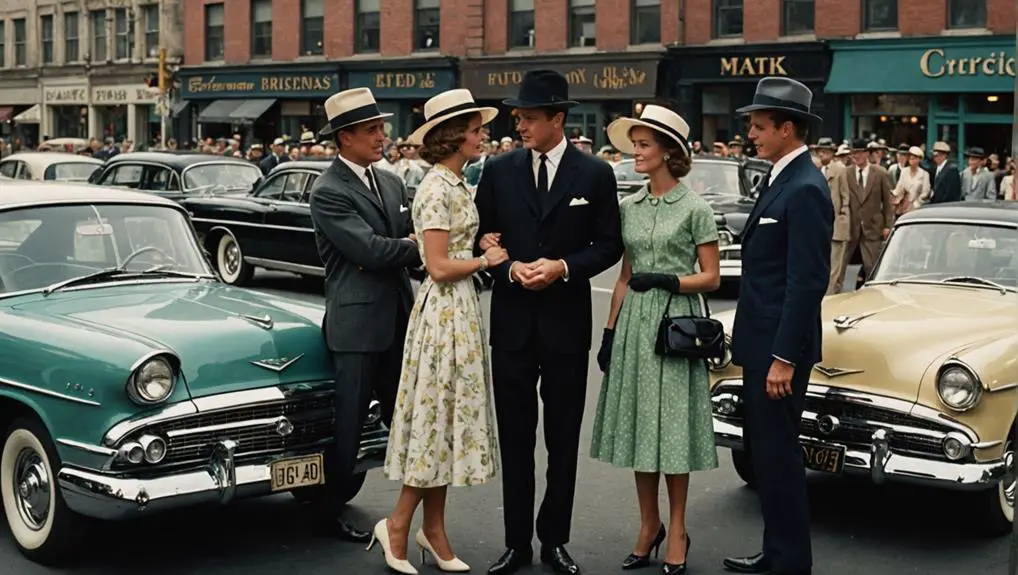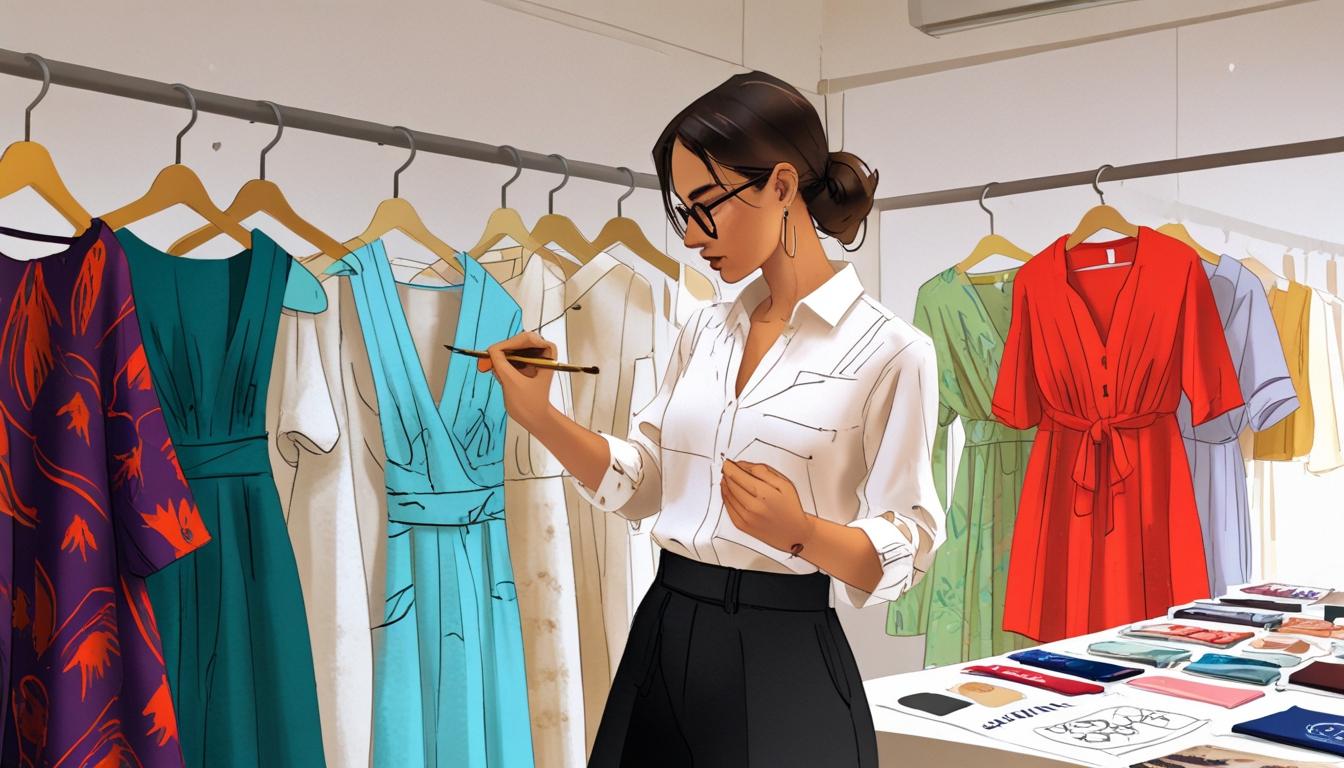In the 1960s, men's hats reflected a dramatic shift in cultural norms and fashion. You'd notice styles evolving, with brim widths shrinking from 3 inches to 2 1/8 inches. The decade saw the rise of bucket hats linked to youth counterculture, alongside military caps inspired by the Vietnam War. Cowboy hats experienced a resurgence through folk music, while traditional fedora styles declined. Nontraditional headwear like beanies and bandannas emerged, symbolizing individuality. The decline in hat wearing began post-JFK's inauguration, as societal views on hats changed. If you explore further, you'll uncover more fascinating details about this vibrant era in men's fashion.
Overview of 1960s Hat Trends
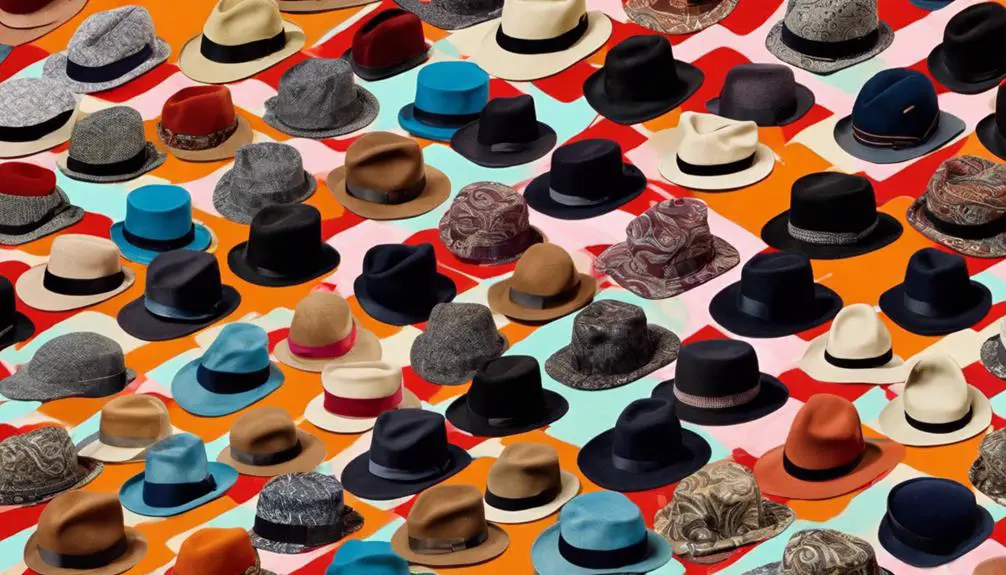
As the 1960s unfolded, you'd notice a significant evolution in men's hat styles that mirrored the decade's dynamic cultural landscape. The trend toward narrower brims became evident, with widths shrinking from 3 inches in 1960 to just 2 1/8 inches by the decade's end. Fedoras and trilbys still held sway among older generations, but emerging styles like the bucket hat, rooted in the Mod subculture, showcased high crowns and ventilation eyelets, reflecting a shift in youthful fashion.
The cultural impact of the Vietnam War further influenced hat trends, leading to the popularity of military caps and the Australian Slouch Hat, which found favor with soldiers and counterculture movements alike. Casual summer styles evolved, with stingy brims gaining traction in the early 1960s, while late-decade straw hats changed into flashy, occasion-based accessories rather than mere seasonal wear.
This era also saw the rise of nontraditional headwear, such as bandannas and beanies, signaling a broader cultural shift towards individuality and self-expression. Fundamentally, the 1960s fashion landscape for men's hats was a reflection of changing societal values and an embrace of diverse styles.
Iconic Hat Styles of the Decade
The 1960s witnessed a vibrant array of iconic hat styles that not only defined personal fashion but also reflected the cultural shifts of the era. The fedora, a staple throughout the decade, saw a significant decline in brim width, tapering from 3 inches in 1960 to just 2 1/8 inches by the decade's end. This evolution mirrored changing tastes in masculinity and sophistication. The trilby emerged as a popular variant, featuring a stingy brim that appealed to both older and younger generations.
Meanwhile, the bucket hat gained traction, especially within the Mod subculture, characterized by its high crown and ventilation eyelets. Often crafted from materials like tweed and houndstooth, these hats were emblematic of youthful rebellion. The Australian Slouch Hat also became a counterculture symbol during the Vietnam War, embraced by both military personnel and antiwar activists, blurring the lines between fashion and political expression.
Cowboy hats enjoyed a revival among folk musicians, showcasing wide brims and chin straps that harkened back to vintage riding styles. Each of these hats contributed to the rich tapestry of 1960s fashion, encapsulating the decade's diverse cultural narratives.
The Rise of Bucket Hats
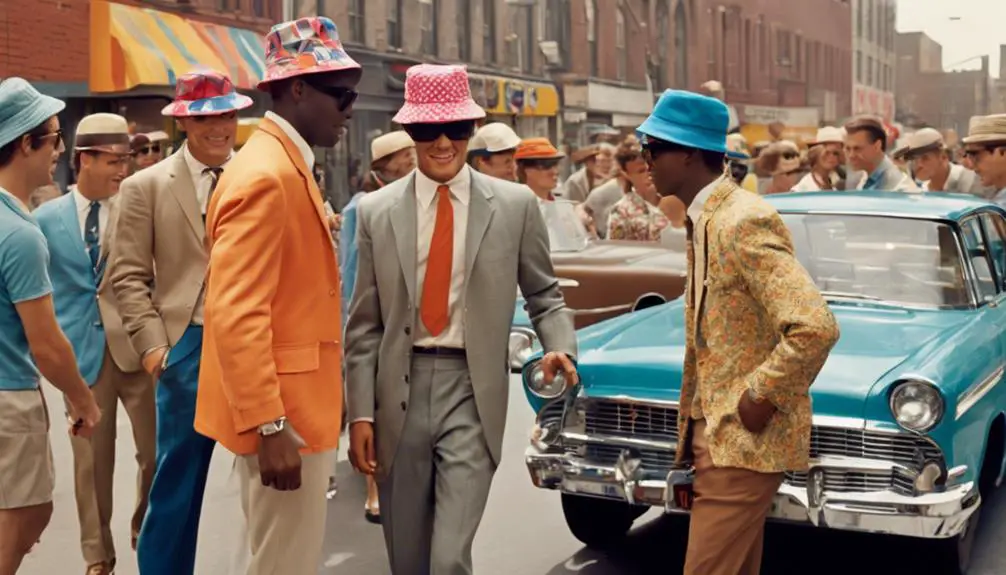
Amidst the shifting tides of 1960s fashion, bucket hats carved out a distinct niche, becoming a quintessential accessory for the era's youthful counterculture. Originally embraced by the Mods, these hats featured high crowns and thick bands, crafted from materials like tweed and plaid. The Vietnam War's influence introduced soft, unstructured designs, adapting the military boonie hats for a new generation. As the popularity of vintage clothing labels grew, enthusiasts began to appreciate the historical context of such accessories, further enhancing their appeal in fashion circles vintage clothing labels.
As bucket hats gained traction, they became emblematic of casual summer styles, reflecting a cultural shift towards leisure and informality. Their popularity surged, fueled by associations with music and arts movements, which positioned them as staples of youthful self-expression.
Key factors contributing to the rise of bucket hats include:
- Versatility: Easily paired with various outfits, they suited both casual and semi-formal occasions.
- Patterns: Available in vibrant floral designs and other unique patterns, they catered to the demand for distinctive fashion statements.
- Cultural Significance: They represented a break from traditional fashion norms, appealing to a younger demographic.
- Influence of Counterculture: Bucket hats symbolized rebellion and individuality, embodying the spirit of the 1960s.
Thus, bucket hats became an enduring icon of the decade.
Casual Summer Hat Innovations
Casual summer hat innovations in the 1960s transformed headwear into an essential element of everyday style. During this decade, casual summer hat styles became more relaxed, with stingy brims gaining popularity in 1961. This shift reflected a desire for less traditional designs, allowing wearers to express individuality. The bucket hat, embraced by the Mod subculture, featured high crowns and thick bands, often crafted from materials like tweed and houndstooth, reinforcing the era's fashion-forward sensibility.
Late in the decade, straw hats emerged, adorned with flashy bands, marking a change from seasonal utility to occasion-based fashion. This alteration appealed to the leisure lifestyle that characterized the time. Meanwhile, counterculture movements greatly influenced trends, with the Australian Slouch Hat becoming a unifying symbol for both military personnel and hippies during the Vietnam War era.
Additionally, the increasing popularity of hats among sportsmen highlighted a broader cultural shift towards casual and practical headwear for summer activities. These innovations not only showcased the evolving tastes of the decade but also illustrated how hats adapted to the changing social landscape, merging functionality with style.
Cultural Influences on Hat Fashion
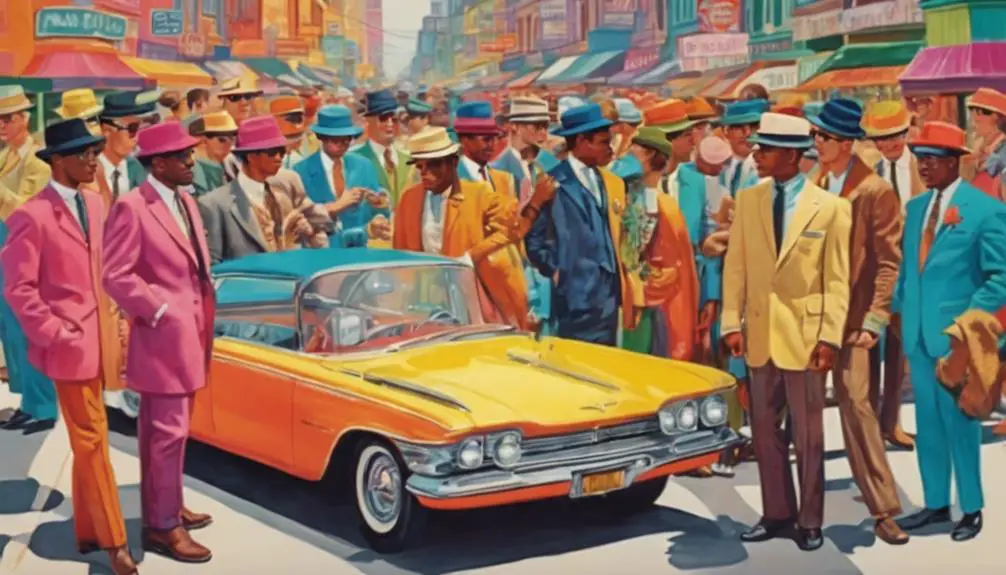
Throughout the 1960s, various cultural movements dramatically shaped hat fashion, creating a vibrant tapestry of styles that reflected societal changes. The Vietnam War played a pivotal role, popularizing the Australian Slouch Hat among military personnel and counterculture groups, embodying a mix of patriotism and protest. This era also saw the revival of the cowboy hat, embraced by folk musicians to evoke nostalgia for Americana and the Old West.
You can see the influence of these movements in the following ways:
- Greek Fisherman's Cap: Gained traction thanks to Marlon Brando's edgy portrayal in "The Wild One," highlighting rebellion.
- Counterculture Movements: The hippie movement fostered a love for individuality, leading to the acceptance of bandannas and beanies.
- Bucket Hats: Inspired by Vietnam War boonie hats, these became a staple in the youthful Mod fashion scene, emphasizing casual and practical aesthetics.
- Mod Fashion: The unstructured designs of bucket hats with bold patterns appealed to those seeking self-expression.
Each of these influences not only shaped hat styles but also reflected the broader cultural shifts of the decade.
Nontraditional Headwear in the 1960s
In the late 1960s, a dramatic shift in headwear emerged as nontraditional styles like bandannas, beanies, scarves, garlands, and headbands captured the imagination of the youth. This cultural shift reflected a desire for individuality and self-expression, moving away from the conservative styles of traditional hat-wearing. Nontraditional headwear became symbols of rebellion, closely tied to counterculture movements such as the hippies and Mods, who embraced these styles as fashion statements that showcased their distinctive identities.
These headwear options often featured vibrant patterns and materials, appealing to a younger demographic enthusiastic to make bold statements. The rise of this headwear trend resulted in a significant decline in the traditional American hat industry, as nontraditional styles became mainstream.
| Nontraditional Headwear | Traditional Hats |
|---|---|
| Vibrant patterns | Conservative styles |
| Symbols of rebellion | Symbols of conformity |
| Youth culture focus | Adult-oriented fashion |
As you can see, the contrast between these two categories highlights the shift in societal norms. Nontraditional headwear marked a departure from the past, illustrating the youth's quest for freedom and personal expression during this transformative decade.
Popular Brands and Their Styles
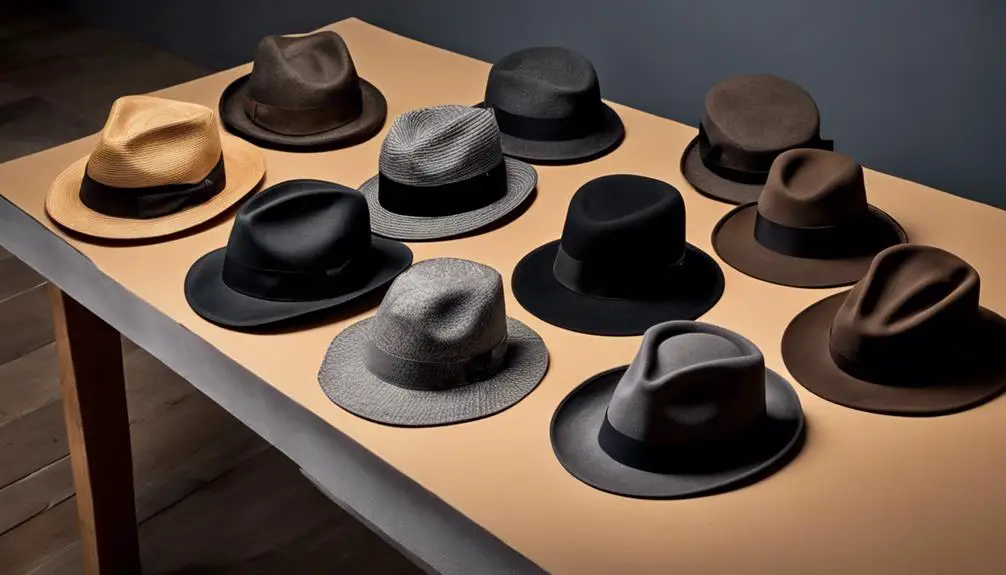
The 1960s witnessed a remarkable evolution in men's headwear, with several brands leading the charge in both innovation and style. When you think of this era, certain names stand out for their contributions to men's fashion.
- Stetson: Known for high-quality cowboy and fedora hats, models like the 3X Beaver and The Sovereign epitomized luxury and craftsmanship.
- Dobbs: This brand offered a variety of fedora and western hat styles, masterfully combining classic design with meticulous attention to detail.
- Brooks Brothers: Featuring unique ambassador hats crafted from dyed Persian lambs wool, Brooks Brothers appealed to men seeking sophistication and elegance.
- Cavanagh: Celebrated for their luxurious felt fedoras available in classic colors, Cavanagh represented a blend of quality and timeless style.
In addition to these, vintage brands like United Hatters produced traditional newsboy caps, highlighting the diversity of styles available. Whether you preferred a classic fedora or a casual newsboy cap, these brands shaped the landscape of men's headwear in the 1960s, allowing you to express individuality and sophistication through your hat choices.
Pricing and Collectibility of Vintage Hats
As you explore the vibrant world of men's hats from the 1960s, understanding their pricing and collectibility can greatly enhance your appreciation for these iconic pieces. Vintage hats can range from as low as $5.99 to an impressive $299.99, making them accessible for various budgets and collector interests. Many online listings offer a "Best Offer" option, allowing you to negotiate prices for those unique pieces that catch your eye.
Specific collectible hats, like a 1950s-1960s Cowboy Hat by Trail Ridge made from Dynafelt, exemplify the high-quality materials used during this era. The condition of the hat plays a crucial role in its pricing; those with original packaging often see a significant boost in value. Limited edition finds, such as the Stetson Nutria quality hat, attract collectors keen to own rare items from the 1960s.
When diving into the world of vintage hats, remember that factors like rarity, condition, and provenance heavily influence pricing and collectibility. As you navigate this landscape, you'll find that the stories behind these hats add to their allure, making them more than just accessories—they're pieces of history.
Regional Variations in Hat Preferences
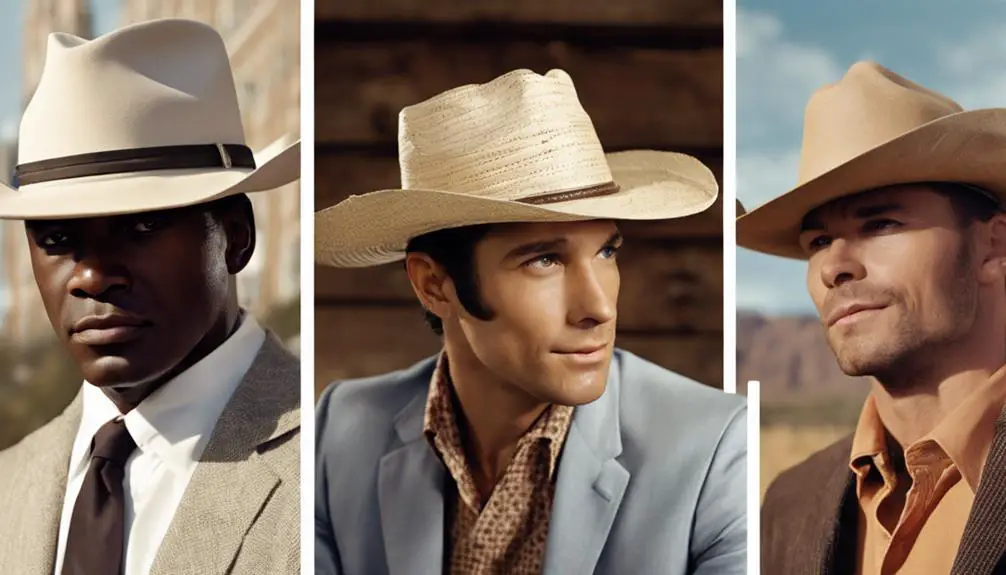
How do regional preferences shape the landscape of men's hat styles from the 1960s? In this decade, various factors influenced what men wore on their heads, revealing a rich tapestry of styles reflective of cultural and environmental differences.
- Northeast: In areas like New Jersey, many men rejected hats, contrasting with the older generation's view that hats symbolized professionalism and respectability.
- Rural Regions: Places like Cumbria embraced flat caps, favoring them for their practicality in farming and outdoor work.
- Climate Influence: Warmer regions opted for lighter materials, like straw or cotton, while cooler climates leaned towards wool and felt for warmth and style.
- Cultural Influences: Local traditions and lifestyles greatly shaped preferences, leading to distinct styles that resonated with the community.
These regional variations not only highlighted the practical aspects of hat-wearing but also showcased the vintage appeal of different styles. Whether it was the classic felt fedora or the casual flat cap, each hat served as a reflection of the wearer's identity, firmly rooting itself in the cultural landscape of the time.
The Decline of Traditional Hat-Wearing
During the early 1960s, a remarkable shift occurred in men's fashion as traditional hat-wearing began to wane dramatically. This decline was greatly influenced by cultural shifts, most prominently marked by JFK's hatless inauguration in 1961. As men stopped wearing hats, the need for headwear diminished, especially with the rise of car culture, which made hats less practical.
In urban areas, younger generations increasingly adopted a hatless style, perceiving traditional hats as symbols of outdated norms. The narrowing brim widths of popular styles, from 3 inches in 1960 to just 2 1/8 inches by the decade's end, illustrated this trend away from traditional headwear.
| Year | Traditional Hat Style | Brim Width | Popular Nontraditional Headwear |
|---|---|---|---|
| 1960 | Fedora | 3 inches | Bandannas |
| 1965 | Narrow-brimmed Fedora | 2.5 inches | Beanies |
| 1970 | Minimalist Hats | 2 1/8 inches | Caps |
| 1975 | Rarely Worn | N/A | Various casual styles |
These changes reflected a broader societal shift, where negative stereotypes associated with traditional hats led to the embrace of nontraditional headwear, showcasing individuality and cultural expression.
Frequently Asked Questions
What Kind of Hats Did Men Wear in the 1960s?
In the 1960s, you'd notice men sporting various hats, from fedoras with narrowing brims to trendy bucket hats embraced by the Mod culture, alongside casual straw styles and emerging nontraditional headwear like beanies and bandannas.
What Hats Did Men Wear in 1950?
In the 1950s, you'd see men sporting fedoras, trilbys, and newsboy caps. The wider-brimmed fedoras dominated, while the trilby appealed to youth, and newsboy caps offered a stylish, casual alternative for all ages.
What Were Men Wearing in the 1960s?
In the 1960s, you'd notice men embracing bold colors and patterns, with tailored suits, relaxed styles, and casual wear reflecting a cultural shift. Accessories like ties and shoes complemented their evolving fashion statements, symbolizing individuality.
Did They Wear Bucket Hats in the 60s?
Yes, you'd find bucket hats in the 60s, especially among Mods. They embraced these hats for their casual style and practicality, showcasing bold patterns that reflected the vibrant fashion trends and counterculture movements of the era.
